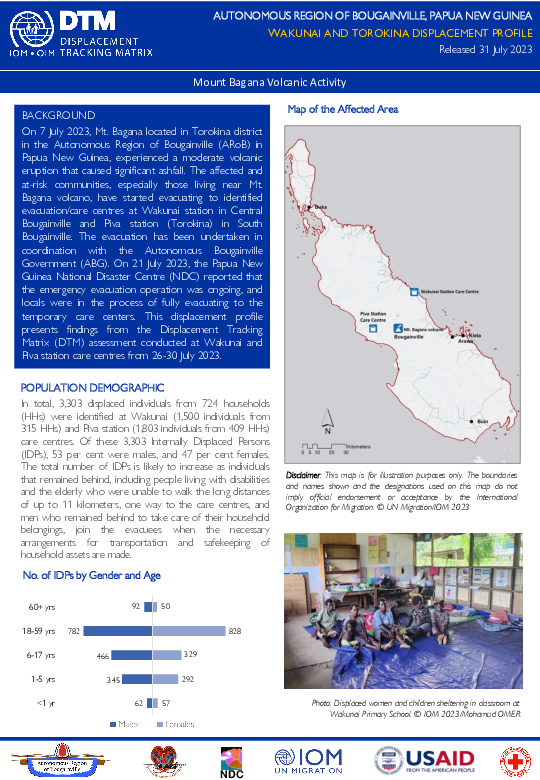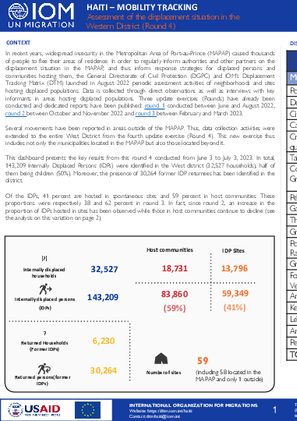-
Countries
-
Data and Analysis
-
Special Focus
-
Crisis Responses
Site Assessment

Contact
IOMPERUDTM@iom.int
Language
Spanish
Location
Peru
Period Covered
May 25 2023
Jun 16 2023
Activity
- Mobility Tracking
- Site Assessment
Según el Centro de Operaciones de Emergencia Nacional (COEN) del Instituto Nacional de Defensa Civil (INDECI, 2023), a mayo de 2023, el gobierno peruano reportó más de 586.000 personas afectadas3, 96.322 personas damnificadas y 36.298 viviendas destruidas o inhabilitadas. A junio de 2023, estas cifras continuaron al alza, registrándose más de 656.000 personas afectadas, 109.027 personas damnificadas y más de 41.000 viviendas destruidas o inhabilitadas.
A ello se sumó la ampliación de la emergencia sanitaria por 120 días, en mayo de 2023, por el récord de casos reportados por dengue. Según el Centro Nacional de Epidemiología, Prevención y Control de Enfermedades (DGE Perú, 2023)8, a junio de 2023, se registraban 98.760 casos de dengue en el Perú, siendo Lambayeque una de las regiones con más casos y mayor probabilidad de albergar enfermedades respiratorias y diarreicas agudas, infecciones de piel, trastornos psicológicos, afecciones crónicas, dengue y leptospirosis.
En respuesta a este contexto, la Organización Internacional para las Migraciones (OIM) presenta la segunda ronda de la Matriz de Seguimiento de Desplazamiento (DTM por sus siglas en inglés) bajo su componente Evaluación de sitio en albergues temporales en la región de Lambayeque, a fin de recopilar información sobre el estado y necesidades de los albergues en esta segunda visita a los albergues, considerando que, entre la primera y segunda visita a los albergues, hubo un periodo de tiempo de 15 días.

Contact
IOMPERUDTM@iom.int
Language
Spanish
Location
Peru
Period Covered
May 11 2023
May 24 2023
Activity
- Mobility Tracking
- Site Assessment
Desde el 5 de marzo de 2023, se registraron fuertes lluvias en diversas ciudades costeras del norte y centro del Perú, así como tormentas eléctricas, que conllevaron a deslizamientos de tierra y desbordamientos de varios ríos que inundaron ciudades y carreteras, así como a daños y destrucciones de viviendas por completo; denominando a este fenómeno climatológico (Ciclón Yaku).
Según la Oficina de Naciones Unidas para la Coordinación de Asuntos Humanitarios en Perú (OCHA Perú, 2023), a marzo de 2023, se estimaron más de 112.800 personas afectadas y más 18 mil personas damnificadas, además de 53.900 viviendas destruidas y el deceso de 71 personas. En este contexto, el 27 de marzo, el gobierno peruano declaró Estado de Emergencia de nivel 5 por 60 días en las regiones de Tumbes, Piura y Lambayeque. Al 24 de abril, estas cifras se alcanzaban las 377.190 personas afectadas3, más de 65 mil personas damnificadas4, más de 146.500 viviendas dañadas y 99 fallecidos (OCHA Perú, 2023).
En respuesta a este contexto, la Organización Internacional para las Migraciones (OIM), empleó la Matriz de Seguimiento de Desplazamiento (DTM por sus siglas en inglés) bajo su componente Evaluación de sitio a fin de recopilar información detallada sobre las condiciones de vida y las necesidades de las personas ubicadas en los albergues temporales previamente identificados en la región de Lambayeque. Así, en mayo de 2023, se inició la realización de encuestas a gestores de los diversos albergues ubicados en Lambayeque, afectados por las intensas lluvias.

Contact
DTM Mozambique, DTMMozambique@iom.int
Language
English
Location
Mozambique
Period Covered
Feb 16 2023
Mar 16 2023
Activity
- Mobility Tracking
- Site Assessment
This Multi-Sectorial Location Assessment (MSLA) report, which presents findings from the International Organization for Migration’s (IOM) Displacement Tracking Matrix (DTM) Round 11 assessments, aims to enhance understanding of the extent of internal displacements and the needs of affected populations in conflict-affected districts of Northern Mozambique. Data was collected between 16 February and 16 March 2023 in close coordination with provincial government and Instituto Nacional de Gestão e Redução do Risco de Desastres (INGD) partners, and presents trends from 92 assessed sites hosting internally displaced persons across Cabo Delgado, 4 sites in Niassa, and 2 sites in Nampula.
In total, 290,401 internally displaced persons (IDPs) (an increase of 5% since the previous round) or 80,295 households were mapped living in sites assessed during this MSLA. Reported figures, however, exclude displaced individuals living in host community settings. According to DTM Round 18 Mobility Tracking Report, as of April, an estimated 834,304 IDPs were identified living in both host communities and sites (781,679 IDPs in Cabo Delgado, 48,635 IDPs in Nampula, and 3,990 IDPs in Niassa).
Contact
DTM Libya, DTMLibya@iom.int
Language
English
Location
Libya
Snapshot Date
Jun 30 2023
Activity
- Mobility Tracking
- Site Assessment
Detention Centre Profiling is a component of IOM Libya’s Displacement Matrix programme. It is a data oriented tool that routinely provides specific sex and age demographic data and key sectorial information on individuals held in Libya’s detention centres on the date of assessment.
Contact
DTM Libya, DTMLibya@iom.int
Language
English
Location
Libya
Snapshot Date
Jul 31 2023
Activity
- Mobility Tracking
- Site Assessment
Detention Centre Profiling is a component of IOM Libya’s Displacement Matrix programme. It is a data oriented tool that routinely provides specific sex and age demographic data and key sectorial information on individuals held in Libya’s detention centres on the date of assessment.
Contact
DTMRCA@iom.int
Location
Central African Republic
Activity
- Mobility Tracking
- Site Assessment
Period Covered
Jul 08 2023 -Jul 14 2023
La zone frontalière entre le Tchad et la préfecture d’Ouham-Pendé
en République centrafricaine (RCA) connaît une détérioration
sécuritaire continue avec la présence de groupes armés non-étatiques
et les conflits communautaires. Des conflits communautaires
impliquant des éleveurs transhumants et agriculteurs tchadiens
ont éclaté à partir du mois d’avril 2023 dans des villages frontaliers
au Tchad. Ces violences ont entraîné la fuite de plus de 28 000
ressortissants tchadiens et 5 617 rapatriés centrafricains qui ont
trouvé refuge en RCA dans les communes de Mia-Pendé, BahBessar et Markounda. C’est dans ce contexte que l’Organisation
Internationale pour les Migrations (OIM) a réalisé à travers la Matrice
de Suivi des Déplacements (Displacement Tracking Matrix, DTM) une
évaluation multisectorielle des besoins auprès des ménages fuyant
les violences au Tchad et des ménages hôtes qui les hébergent afin
d’informer les stratégies et programmes des acteurs humanitaires
et du gouvernement. La collecte de données a été réalisée entre
le samedi 8 et le vendredi 21 juillet dans les communes de MiaPendé et de Bah-Bessar dans la préfecture d’Ouham-Pendé avec la
participation du Projet d’Appui au Retour et à la Réintégration en
RCA (PARET).
Population Groups
Survey Methodology
Unit of Analysis Or Observation
Type of Survey or Assessment
Keywords
Geographical Scope
Administrative boundaries with available data
The current dataset covers the following administrative boundaries
Contact
DTM Pakistan, DTMPakistan@iom.int
Location
Pakistan
Activity
- Survey
- Flow Monitoring
- Mobility Tracking
- Site Assessment
Period Covered
Jan 01 2021 -Dec 31 2021
27,829 undocumented returnees were reported to have crossed the two borders, out of which 14,185 were females and 13,644 were males. Additionally, border authorities facilitated the return of 1,740 individuals due to the lack of legal documentation to remain in Pakistan. Therefore, information concerning these 1,740 individuals is not included in the report analysis.
Population Groups
Survey Methodology
Unit of Analysis Or Observation
Type of Survey or Assessment
Keywords
Geographical Scope
Administrative boundaries with available data
The current dataset covers the following administrative boundaries
Contact
DTM Pakistan, DTMPakistan@iom.int
Location
Pakistan
Activity
- Mobility Tracking
- Site Assessment
Period Covered
Aug 17 2022 -Jan 12 2023
An estimated total of 1,591,367 temporary displaced persons (TDPs) were identified during this round in the 18 districts of Balochistan, Khyber Pakhtunkhwa and Sindh. Fifty-five per cent of TDP households (113,070) were living in temporary structures (i.e. tents or emergency shelter).
Population Groups
Survey Methodology
Unit of Analysis Or Observation
Type of Survey or Assessment
Keywords
Geographical Scope
Administrative boundaries with available data
The current dataset covers the following administrative boundaries

Contact
DTM Papua New Guinea, iompngmdac@iom.int
Language
English
Location
Papua New Guinea
Period Covered
Jul 26 2023
Jul 30 2023
Activity
- Mobility Tracking
- Site Assessment
- Baseline Assessment
On 7 July 2023, Mt. Bagana located in Torokina district in the Autonomous Region of Bougainville (ARoB) in Papua New Guinea, experienced a moderate volcanic eruption that caused significant ashfall. The affected and at-risk communities, especially those living near Mt. Bagana volcano, have started evacuating to identified evacuation/care centres at Wakunai station in Central Bougainville and Piva station (Torokina) in South Bougainville. The evacuation has been undertaken in coordination with the Autonomous Bougainville Government (ABG). On 21 July 2023, the Papua New Guinea National Disaster Centre (NDC) reported that the emergency evacuation operation was ongoing, and locals were in the process of fully evacuating to the temporary care centres. This displacement profile presents findings from the Displacement Tracking Matrix (DTM) assessment conducted at Wakunai and Piva station care centres from 26-30 July 2023.

Contact
DTM Haiti, DTMHaiti@iom.int
Language
English
Location
Haiti
Period Covered
Jun 03 2023
Jul 03 2023
Activity
- Mobility Tracking
- Site Assessment
- Baseline Assessment
- Village Assessment
In recent years, widespread insecurity in the Metropolitan Area of Port-au-Prince (MAPAP) caused thousands of people to flee their areas of residence. In order to regularly inform authorities and other partners on the displacement situation in the MAPAP, and thus inform response strategies for displaced persons and communities hosting them, the General Directorate of Civil Protection (DGPC) and IOM’s Displacement Tracking Matrix (DTM) launched in August 2022 periodic assessment activities of neighborhoods and sites hosting displaced populations. Data is collected through direct observations as well as interviews with key informants in areas hosting displaced populations. Three update exercises (Rounds) have already been conducted and dedicated reports have been published: round 1 conducted between June and August 2022, round 2 between October and November 2022 and round 3 between February and March 2023. Several movements have been reported in areas outside of the MAPAP. Thus, data collection activities were extended to the entire West District from the fourth update exercise (Round 4). This new exercise thus includes not only the municipalities located in the MAPAP but also those located beyond it. This dashboard presents the key results from this round 4 conducted from June 3 to July 3, 2023. In total, 143,209 Internally Displaced Persons (IDPs) were identified in the West district (32,527 households), half of them being children (50%). Moreover, the presence of 30,264 former IDP returnees has been identified in the district. Of the IDPs, 41 percent are hosted in spontaneous sites and 59 percent in host communities. These proportions were respectively 38 and 62 percent in round 3. In fact, since round 2, an increase in the proportion of IDPs hosted in sites has been observed while those in host communities continue to decline
Pagination
- Previous page
- Page 20
- Next page
